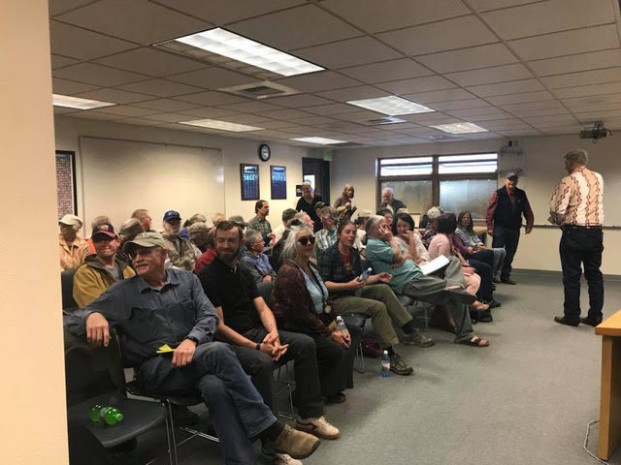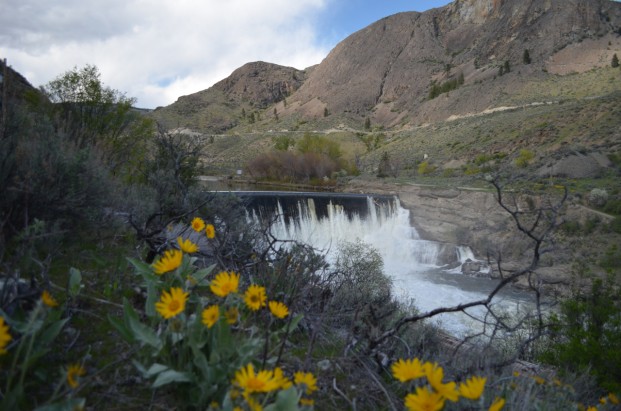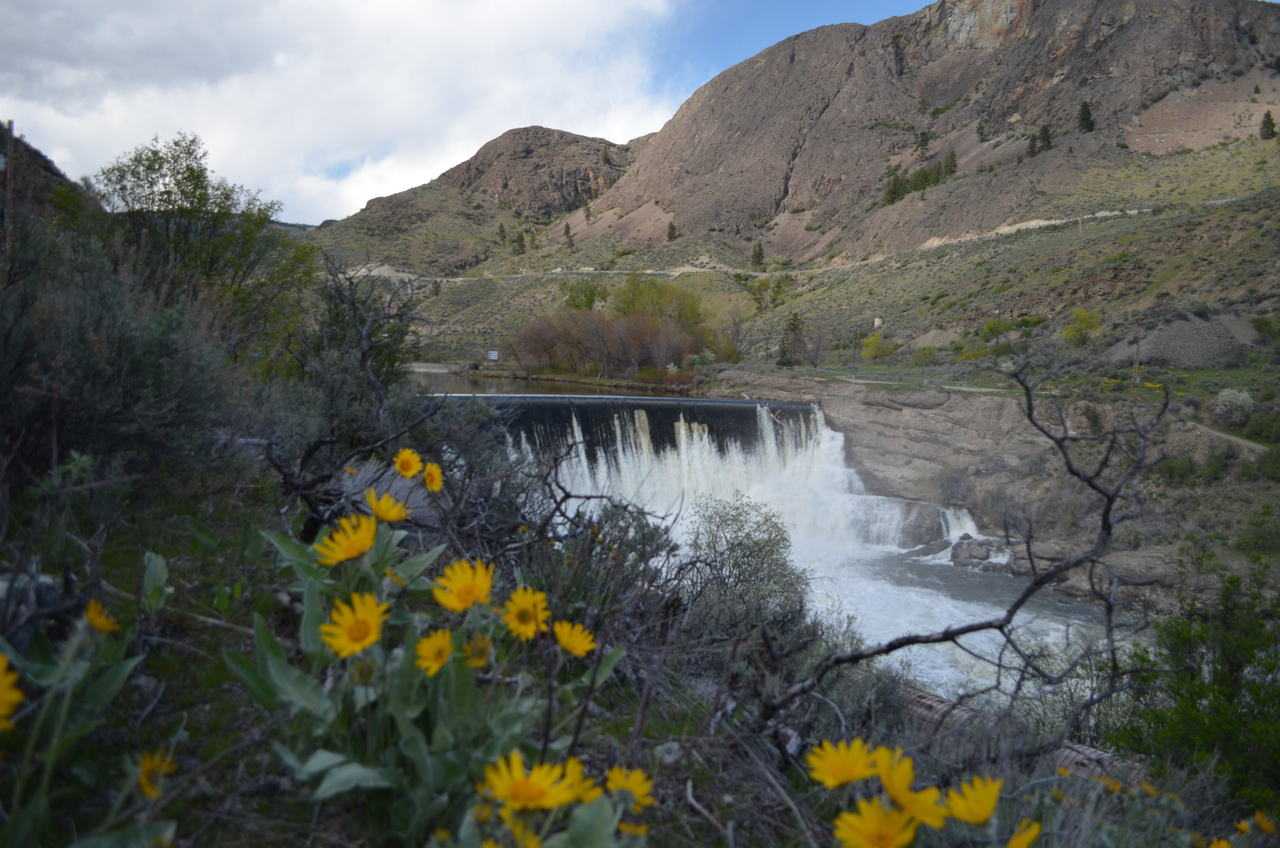
TONASKET – Okanogan County PUD Commissioners Jerry Asmussen, Scott Vejraska and Bill Colyer met with community members last week for a “listening session” after signing a contract to begin Phase 1 of the Enloe Hydroelectric Project (Project).
Enloe Dam, along with a 3.6 MW hydroelectric power plant, was constructed on the Similkameen River west of Oroville in the early 1920s and shut down in 1958 due to more affordable electric power being available from the Bonneville Power Administration. PUD commissioners have been seeking re-electrification of the dam for the past several years.
“Phase 1 is part of the design build process that has been going on for a number of years, the permits and lawsuits we have struggled with through the years,” said Commissioner Asmussen. The Gazette-Tribune’s requests for comment from Commissioners Vejraska and Colyer went unanswered.
“The purpose of the meeting was an effort by us to hold our meetings in the outlying areas of our district so people can attend. It’s focus wasn’t on just the Enloe project,” said Asmussen. “The effort made with the ad was from the dam opponents, so that’s who was mostly there.”
Around 50 people were in attendance at the April 23 meeting to question the choice to re-electrify the dam. Attendees included Salley Bull of Oroville, a District 3 candidate for county commissioner, and Chewela’s Karen Hardy, a candidate for State Senate.
“It was not an official meeting, so no minutes were kept,” said Bull. “The commissioners opened the “listening” meeting to a roomful of attendees. Most were against re-electrifying the nearly 100-year-old dam. A few were middle-of-the-roaders, and at least one person was for approval.”
Bull said she attended the meeting to hear what the commissioners had to say, as well as remind those in attendance of the county’s poverty level.
“It would be irresponsible to burden all these people to pay for a project that will be run in the red for at least 20 years, causing rates to permanently raise,” said Bull.
According to Bull, numbers supplied by the PUD estimate ratepayers’ bills can be expected to increase by an average of about $10-$15 per month and $30 in the winter months.
“That may not sound like much, but government projects tend to run over budget, so actual costs could be two, three or four times as much—and that is a substantial increase,” said Bull.
PUD Commissioners authorized Interim General Manager Don Coppock to sign the contract for Phase 1 Monday, April 9, with Design-Build contractor Max J. Kuney Co. of Spokane in partnership with Tetra Tech, Inc. of Bellevue. The 180-day contract with Kuney is not to exceed $1,794,346 ($1.8 million).
“At the end of Phase 1, we will have a price tag for the whole project,” said Asmussen. “There will be, I’m sure, a few unknowns left, but it will get us pretty close to a price tag. Anticipated costs so far, are still what were in our FERC (Federal Energy Regulation Committee) license, but these numbers will be closer, as the FERC license is almost eight years old, and things go up.”
The PUD applied for a license with FERC in 2008, finally receiving the license in 2013 to construct a new power plant at the dam (three previous licenses had stipulated reconstruction of the original power plant). When the two-year deadline to begin construction arrived, the PUD received a stay from FERC to extend the timeline.
In late 2016, the PUD received unanimous approval from the Washington State Capital Projects Review Committee (PRC) to use the Design-Build contracting procedure on the Project. The PRC’s decision was appealed and rescinded before being reheard, resulting in a second approval by the PRC several months later.
Oroville resident and long-time outspoken opponent of re-electrification of the dam, Joseph Enzensperger, said by the time the PUD received the license in 2013, the utility had spent $12 million in lawyer, engineer and consultants’ fees.
“Spending has continued, and by October of this year the PUD’s spending on the Enloe Project will approach $17 million,” said Enzensperger, adding that ratepayers attended the meeting to question the “rationale behind this growing capital outlay.”
The PUD stated one reason a Design-Build method was selected was hydropower project development is a highly specialized field requiring early contractor involvement to address construct-ability issues, develop practical construction plans and to address environmental plans and protection measures; calling it a “collaborative process.”
During Phase 1, a 30 percent design will be finalized, with not-to-exceed project costs developed and a construction schedule set. The PUD’s stated goal is to move forward with a Phase 2 not-to-exceed contract for construction.
New facilities to be constructed include a river intake upstream of the existing dam, intake channel, penstock structure and steel penstocks that will divert water available for power generation to the new power plant; a new 9 MW hydroelectric power plant, a tailrace channel that will return flow to the river downstream of the dam; a new substation and a short transmission interconnection to the District’s existing 13.2 kV electric power distribution system.
Improvements to the public recreation facilities and development of new fish rearing facilities are also part of project plans.
The PUD estimates average annual generation of the licensed project at 45 Gwh/year, equivalent to the typical annual electric energy consumption of about 3,600 homes.
“It’s not much, but we knew we had to spend money to have those studies done, so we did want to have some output from the dam to offset those studies,” said former PUD Commissioner David Womack, a proponent of the project since it’s conception.
“Power production at Enloe Dam is 4.5MW average output. It is doubtful that Enloe Dam will ever generate enough electricity to pay for itself,” said Enzensperger. “We will have a small amount of locally generated power, but there will be no economic return for the ratepayers’ loss of income.”
Asked what he saw as the main benefit of the Project, Asmussen responded, “It’s either an asset or a liability and I prefer to see it as a performing asset. This is the way, the paths the previous boards have gone down. A project of this scale, you don’t just jump in and out of it on a whim.”
“I get it, you have a dam, and you don’t know the future availability of electric,” said Hardy. I am a protect-and-preserve, use-what-you’ve-got person. But there comes a point when things have outlived their purpose.”
Enzensperger pointed out the new powerhouse on the east side of the river is expected to cost $30-$0 million to construct, with ratepayers forking over an additional $20-$30 million in interest over 20 years.
“It will add an additional $2-$3 million to the annual PUD debt service now at $3.7 million,” said Enzensperger. “According to PUD estimates, the energy produced at Enloe Dam will be two to three times more expensive than open market power. ‘Why are we not buying cheaper power elsewhere as we need it?’ was a question frequently asked.”
Hardy said when she first started to run for State Senate, she had a lot of potential constituents asking her about the Project, so she made it a priority to find out about it.
“I talked to commissioners at the Okanogan County Fair, and said ‘talk to me about this. Sell me on this project,’” said Hardy. “They are caught between a rock and a hard place with this FERC license. If they don’t meet the requirements by 2019 to begin construction, then it is done and over. They have gone this far and have spent a lot of money, and I think they feel like they have to try to do it. That is a lot of the county’s money you have committed, and it’s tough to walk away from the millions of dollars of work, and come out with nothing. That’s a tough one. But that doesn’t make it a good project. If you have to force something, you probably want to step back and take another look at it.”
Several community members said they left the meeting feeling certain the PUD was not willing to step back, after listening to ratepayers.
“The public became noticeably frustrated by the PUD’s continued pursuance to re-electrify Enloe Dam. What seemed to concern the ratepayers the most was that the power projected to be produced at Enloe Dam will be higher than other sources in the region,” reported Jere Gillespie. “With a continued effort by the PUD to energize Enloe Dam in a relative disregard by public opposition, a couple attendees of the meeting suggested taking legal action; to which Commissioner Asmussen responded, “We have been sued before an have won.” But what is troubling by Commissioner Asmussen’s comment is the commissioners are elected officials to represent the public. Instead of understanding and responding to the public, they act in a defiant manner.”
When asked if there was anyone at the meeting who spoke up in favor of re-electrification, Asmussen responded, “Yes, there was support. I would say 10 percent of the comments were in support.”
Hardy said when she spoke with Commissioner Asmussen at the Okanogan County Fair last fall, he told her he had 50 percent support on the project.
“I told him, ‘Jerry, I am all over this district, and I’m telling you, you don’t have 50 percent of the district’s support. I don’t have a dog in this fight, but I have been running for office in this district for a year and talking to people, and it’s not at 50 percent,” said Hardy. “And the more people learn about it, the more concern there is. I do applaud them for having the meeting, it was a good meeting and people were polite. But it definitely sounded like the commissioners had made up their minds.”
Hardy said what made it apparent to her the commissioners were on a predetermined path was their refusal to test the soil behind the dam.
“The SEPA and NEPA, state and national environmental protection agencies, did a study on the sediment behind the dam, but only did it down so far, and didn’t find anything in the first top eight feet. If they’re re-electrifying it, there is nothing toxic in the top layer that would cause any environmental concerns. But they only did the study to check for re-electrification of the dam, not for dam removal,” Hardy pointed out. “They didn’t actually look to see what was there deeper, so it seems like a decision they’ve already made.”
“Most of the comments given during the meeting concerned the PUD’s lack of getting a an appropriate soil sample, one that tests to the actual original bottom of the river bed. The dam is 54′ tall, with about eight feet of water behind it. So about 40′ of silt is settled behind the dam. The PUD chose to test only a few inches—what they considered would be disturbed by the construction activities. They stated it was clean,” said Bull. “They did not agree to do a more extensive soil sample, stating that at an estimated cost of $100,000, it was too expensive. This is in light of spending $14 million to get the license and they will $1.8 million to have plans drawn up this year. Their estimate of $35 million is for construction. Their argument to proceed is it would cost too much to dismantle it, even though an agency has offered to be the Lead Agency; and organizations have offered to raise money to pay for it.”
The FERC license requires the PUD to either electrify or dismantle the dam.
“If you want to electrify it, let’s talk. But it seems to me where we want to start is by addressing what is in the sediment behind the dam,” said Hardy. “Because of the salmon habitat downstream, they can’t allow any sediment to travel down the river. They are using scare tactics to tell people about a bunch of toxic stuff behind the dam that they don’t actually know is there. If they only looked at the top layer, they have no intentions of taking it down.”
“The toxicity of those sediments cannot be determined without an accurate sediment study,” said Enzensperger. “We cannot determine dam removal costs or the liability of dam removal without that information. Not knowing the real facts has allowed the PUD to wildly speculate about the cost of dam removal, suggesting costs could run as high as $350 million up to $1 billion. A fully-funded scientific study and analysis of the sediments would cost approximately $100,000. In the opinion of most ratepayers in attendance, that would be money well spent.”
Hardy and Enzensperger both pointed out that plans for the Project call for blasting of large amounts of rock from the bedrock and canyon walls of the Similkameen River, above and below the dam’s attachment to the rock canyon walls.
“If they set off dynamite to both sides of the river above and below the dam, that could cause the dam to fail,” said Hardy.
“Blasting will be done above the dam for the new holding pond, and below the dam to site the new powerhouse,” said Enzensperger. “This fourth license calls for a new powerhouse on the east side, and demolition of the old historic landmark now perched on the west bank of the river. There are real risks associated with this project.”
“What happens if we electrify it, then find out there is toxic stuff behind it, then have to shut it down?” asked Hardy. “They say they don’t want to take it down because they don’t know what is behind it, but they know when they are done with the power plant, they will have to take the dam down, whether that is in 10 years or 100 years.”
“In 100 years, technology of removal could change, and could affect the mitigation costs of downstream effects,” said Womack.
Hardy said she was shocked by how many people showed up at the meeting.
“I go to a lot of meetings across the district, and often no one shows up; or very few. To have 50 people show up on a Monday night, willing to talk and willing to listen, and be a part of their community, that’s a real positive thing. The citizens there were incredibly well-informed about the dam. They understood the entire scope of the issue. There was a lot the PUD Commissioners couldn’t tell me about the dam, for instance they didn’t know it was 54′ tall. It was impressive to see how well-educated and informed the citizens were. They’ve got a handle on this, and while you might not agree with them, these were fact-based arguments they were presenting.”
“This is clearly a significant issue of our times,” said Enzensperger. “Those in attendance clearly opposed the electrification by about 25:1. The commissioners did not seem to be moved. We will wait until the next regular meeting on Monday, May 7 at 3 p.m. to see if they heard anything to inform their thinking. If they did, we will wait to see what they are going to do about it.”
“Are they not servants of the Public Utility District? Are the commissioners not supposed to act upon the majority opinion of the ratepayers?” asked Gillespie. “How are their actions, at least in regards to re-energizing Enloe Dam, in the best interest of the ratepayers of Okanogan County?”
“The people of the area deserve a more responsive leadership,” said Hardy. “That’s why they elected new PUD Commissioners. The new ones don’t seem to understand that’s why the old ones are gone.”







